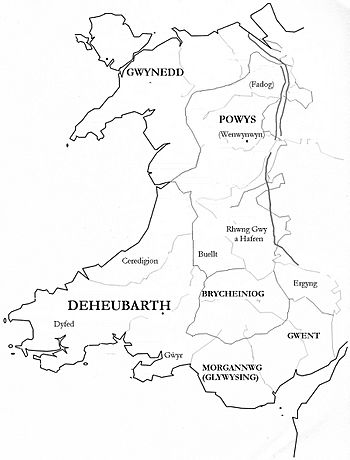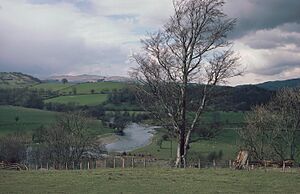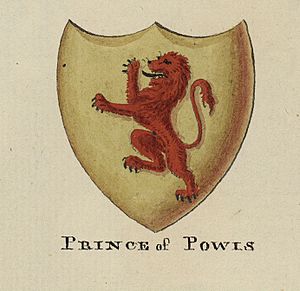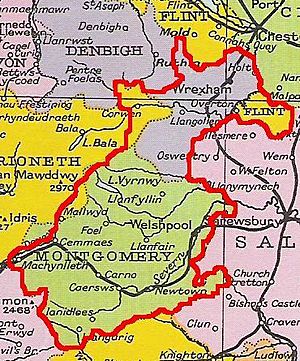Kingdom of Powys facts for kids
Quick facts for kids
Kingdom of Powys
Teyrnas Powys
|
|||||||||||
|---|---|---|---|---|---|---|---|---|---|---|---|
| 5th century–1160 | |||||||||||
|
Anthem: Unbennaeth Prydain
"The Monarchy of Britain" |
|||||||||||

Medieval kingdoms of Wales
|
|||||||||||
| Capital | Caer Guricon, Pengwern (possibly), Mathrafal, Welshpool, Chester | ||||||||||
| Common languages | Welsh | ||||||||||
| Religion | Celtic Christianity | ||||||||||
| Government | Monarchy | ||||||||||
|
• 6th century
|
Brochwel Ysgithrog | ||||||||||
|
• d. 616
|
Selyf ap Cynan | ||||||||||
|
• d. 755
|
Elisedd ap Gwylog | ||||||||||
| Historical era | Middle Ages | ||||||||||
| 5th century | |||||||||||
| 1160 | |||||||||||
| Currency | ceiniog cyfreith & ceiniog cwta |
||||||||||
|
|||||||||||
|
Demonym: Powyssi; Powysian
|
|||||||||||
The Kingdom of Powys (called Teyrnas Powys in Welsh) was an important Welsh kingdom during the Middle Ages. It appeared after the end of Roman rule in Britain in the 5th century. Powys covered a large area of what is now central Wales and parts of England.
Its borders stretched from the Cambrian Mountains in the west to the West Midlands in England. This area included the rich river valleys of the Severn and Tern. People in old Welsh stories called this fertile land "the Paradise of Powys."
Contents
What's in a Name? The Meaning of Powys
The name Powys likely comes from the Latin word pagus. This word means 'the countryside'. Pagenses meant 'dwellers in the countryside'. You can see similar words in French ("pays") and English ("peasant").
During the Roman Empire, this area was a Roman province. Its main city was Viroconium Cornoviorum, which is now Wroxeter. This was one of the biggest Roman cities in Britain. Later, the capital moved to Deva Victrix (modern Chester). An old Welsh record says that the land of Powys was once known as Teyrnllwg.
Early Days: The Kingdom's Beginnings
In the Early Middle Ages, the Gwertherion family ruled Powys. This family said they were related to Vortigern, a famous British leader. They also claimed a link to Princess Sevira, daughter of the Roman leader Magnus Maximus.
Archaeological finds show that Viroconium Cornoviorum stayed an important city until the 6th century. It might have been the capital of Powys. An old book called Historia Brittonum mentions it as Caer Guricon.
Over time, English settlers from Mercia started moving into Powys's eastern lands. This was a slow process. English control in the West Midlands wasn't strong until the late 8th century.
Challenges and Changes
Around 549, a terrible sickness called the Plague of Justinian reached Britain. It badly affected Welsh communities. Many villages became empty. However, the English were less affected because they didn't trade as much with other countries.
Because of fewer people and more English attacks, King Brochwel Ysgithrog might have moved his court. He may have moved it from Caer Guricon to Pengwern. We don't know exactly where Pengwern was. It might have been near Shrewsbury or at a hill fort called Din Gwrygon on The Wrekin.
In 616, King Æthelfrith of Northumbria attacked Powys. He wanted to separate the Welsh in the north from those in Rheged. Æthelfrith fought a big battle near Chester. He defeated King Selyf and his allies. Before the battle, Æthelfrith killed 1,200 monks from the monastery of Bangor-on-Dee. He said they were praying against him. King Selyf ap Cynan was also killed in this battle. He might have been the first Powys king buried at St. Tysilio's church in Meifod. This church became the burial place for the royal family.
Fighting Back and Building Borders
Powys became stronger again with successful fights against the English. These happened in 655, 705–707, and 722. The royal court moved to Mathrafal Castle by 717. King Elisedd ap Gwylog (who died around 755) might have moved it.
Elisedd's victories led King Æthelbald of Mercia to build Wat's Dyke. This was a large earth wall. It might have been built with Elisedd's agreement. This border gave Oswestry (called Croesoswallt in Welsh) to Powys.
Later, King Offa of Mercia built an even bigger earthwork, Offa's Dyke (Clawdd Offa). This dyke was planned with the Welsh kings. For example, near Trelystan, the dyke moved east. This left fertile lands for the Welsh. Near Rhiwabon, it made sure that Cadell ap Brochfael kept his fortress.
This new border moved Oswestry back to the English side. Offa attacked Powys several times between 760 and 796. Offa's Dyke mostly stayed the border between Wales and England. However, by the 12th century, the Welsh took back land between the Dee and the River Conwy. This area was called the Perfeddwlad or "Midlands."
Uniting Wales: Rhodri, Hywel, and Gruffydd
Powys joined with Gwynedd when King Merfyn Frych of Gwynedd married Princess Nest ferch Cadell. Nest was the daughter of King Cyngen of Powys. Cyngen was the last ruler of the Gwertherion family.
When Cyngen died in 855, Rhodri the Great became King of Powys. He had already inherited Gwynedd the year before. This event was the start of Gwynedd's claims to rule over Powys for the next 443 years.
Rhodri the Great ruled most of modern Wales until he died in 878. His sons later started their own ruling families. These families became very important in Welsh history. Each claimed to be related to Rhodri. Merfyn inherited Powys. His brothers, Anarawd ap Rhodri and Cadell, started the Aberffraw family in Gwynedd and the Dinefwr family.
In 942, Hywel Dda of Deheubarth took control of Gwynedd. He was Rhodri's grandson. He also took Powys from Llywelyn ap Merfyn. Hywel was known for his good relationship with Æthelstan, King of the Anglo-Saxons. He often visited Æthelstan's court.
Hywel studied the English legal system. He then changed Welsh law in his own lands. These laws were later called the Cyfraith Hywel or "Laws of Hywel." He even took his laws to Rome in 928, and they were supposedly blessed by the Pope.
Hywel encouraged the use of coins in Wales. His coins were made in Chester. This was a benefit of his good relations with England. In 945, Hywel held a meeting in Whitland to organize his law codes. People called him the good (Hywel Dda) because his rule was unusually peaceful. After he died, Gwynedd went back to the Aberffraw family. Powys and Deheubarth were divided among his sons.
Later, Maredudd ab Owain rebuilt his grandfather Hywel Dda's kingdom. He was king of Deheubarth and Powys by 986. He also took Gwynedd. Maredudd fought off English attacks in Powys and Viking raids in Gwynedd. He even paid a large sum of money to get back people captured by Vikings.
When Maredudd died in 999, Powys went to his grandson Llywelyn ap Seisyll. Llywelyn's son, Gruffydd, united all of Wales under his rule. He even expanded into England. After Gruffydd died, Powys returned to the Mathrafal family.
The Mathrafal Family and Powys's Division
The Mathrafal family started through Princess Anghared. She was the daughter of Maredudd ab Owain. Her second husband was Cynfyn ap Gwerstan. The family is named after their historic home, Mathrafal Castle.
Anghared's son, Bleddyn ap Cynfyn, became ruler of Powys in 1063. This happened after his half-brother Gruffydd ap Llywelyn died. Bleddyn (whose name means 'wolf' in Welsh) also secured Gwynedd. King Edward the Confessor of England supported Bleddyn's rule. Bleddyn also updated the Law Codes of Hywel Dda.
Fighting the Normans
Bleddyn ap Cynfyn and his brother Rhiwallon fought with the Anglo-Saxons against the Norman Invasion. In 1067, they joined with Eadric the Wild to attack the Normans at Hereford. In 1068, they attacked the Normans again with Earl Edwin and Earl Morcar.
In 1070, Bleddyn defeated his half-nephews in a battle. They were trying to take Gwynedd. Bleddyn ap Cynfyn himself was killed in 1075 while fighting in Deheubarth. After Bleddyn's death, Powys was divided among his sons and grandsons. Gwynedd went back to the Aberffraw family.
After William the Conqueror took control of England, he let his Norman lords take land from the Welsh. This created the Welsh Marches along the border. By 1086, the Norman Earl Roger de Montgomery built Montgomery Castle. Other Normans took more lands in northern Powys. By 1090, most of Powys was in Norman hands.
Bleddyn ap Cynfyn's three sons led the fight back. By 1096, they had retaken most of Powys, including Montgomery Castle.
The Kingdom Splits
During the 12th and 13th centuries, the Mathrafal family struggled to keep their lands. They faced Norman lords and a strong Gwynedd. After 1160, when Madog ap Maredudd died, his kingdom was divided. His son and chosen heir, Llywelyn ap Madog, was killed.
The kingdom split along the River Rhaeadr:
- Lands north of the Rhaeadr went to Madog's remaining sons. These areas became Powys Fadog.
- Lands south of the Rhaeadr went to Owain, Madog's nephew. These areas became Powys Wenwynwyn.
- The area spanning the Rhaeadr, Mochnant, went to Madog's half-brother, Iorwerth Goch ap Maredudd.
In 1166, Owain Cyfeiliog and Owain Fychan attacked Iorwerth Goch. They forced him out of Mochnant and divided the land. By the end of the century, the two main parts of Powys were known as Powys Fadog and Powys Wenwynwyn.
Outside Influences
The princes of Gwynedd, like Llywelyn Fawr, became very powerful. Powys Fadog often supported them. However, Powys Wenwynwyn often argued with Gwynedd. Gwynedd tried to take over Powys Wenwynwyn many times.
King Henry III of England forced Gwynedd to let Gwenwynwyn's son, Gruffydd, rule Powys Wenwynwyn again. But Llywelyn ap Gruffudd, Prince of Gwynedd, became so strong that both parts of Powys accepted him as Prince of Wales by 1263.
In 1274, Gruffydd of Powys Wenwynwyn broke his loyalty to Llywelyn. Gruffydd was forced to go to England. The next year, King Edward I declared Llywelyn a rebel. Edward launched a big attack on Gwynedd. This attack helped Gruffydd get his power back. Gruffydd's son, Owain, even changed his name to Owen de la Pole. He took his new name from the capital of Powys Wenwynwyn, Pool.
In 1282, Llywelyn attacked the Perfeddwlad. This led to a huge counter-attack by King Edward. Gruffydd ap Gwenwynwyn's forces helped defeat Gwynedd. They ambushed and killed Llywelyn.
The End of the Kingdom
Powys Fadog had sided with Gwynedd during Edward's invasion in 1282. So, in 1283, after Edward defeated Gwynedd, he ended Powys Fadog. He gave much of its land to John de Warenne, 6th Earl of Surrey. This became the Marcher Lordship of Bromfield and Yale.
However, a small part of Powys Fadog was given back to Gruffudd Fychan. This area, around Sycharth and Glyndyfrdwy, became a Barony. It lasted until the rebellion of Owain Glyndŵr, who was a descendant of Gruffudd Fychan.
Owen de la Pole, who had supported King Edward, made his position stronger in Powys Wenwynwyn. He turned it into a marcher lordship called the Lordship of Powis. This made him a vassal of Edward I. This meant he could rely on English support while still being mostly independent.
The name Powys for this area disappeared by the 1500s. This happened when the Laws in Wales Acts 1535–1542 incorporated the marcher lordships into counties. Powys Fadog became part of Denbighshire. Powys Wenwynwyn mostly became Montgomeryshire.
The Lordship of Powis continued as a barony. In 1551, the Baron of Powis died without legal children. The land was sold to Sir Edward Herbert. His son later became Baron Powis. His descendants became Marquesses and Earls of Powis. They still live at Powis Castle.
Powys was not brought back as a political area until 1974. That year, new boundaries created a larger county of Powys. This new county combined Montgomeryshire, Brecknockshire, and Radnorshire. However, much of the old Powys Fadog became part of the new county of Clwyd.
Rulers of Powys
- House of Gwerthrynion
- Gwrtheyrn (High-King Vortigern), married to Sevira, daughter of Magnus Maximus
- Cadeyern Fendigaid (c. 430–447); eldest son of Gwrtheyrn, blessed by Saint Germanus
- House of Ternyllwg
- Cadell Ddyrnllwg (c. 447–460)
- Rhyddfedd Frych (c. 480)
- Cyngen Glodrydd (c. 500)
- Pasgen ap Cyngen (c. 530)
- Morgan ap Pasgen (c. 540)
- Brochwel Ysgithrog (c. 550)
- Iago ap Brochwel (?–582)
- Cynan Garwyn (582–610)
- Selyf ap Cynan (610–613)
- Manwgan ap Selyf (613)
- Eiludd Powys (613–?)
- Beli ap Eiludd (c. 655)
- Gwylog ap Beli (695–725)
- Elisedd ap Gwylog (725–755?)
- Brochfael ap Elisedd (755?–773)
- Cadell ap Brochfael (773–808)
- Cyngen ap Cadell (808–854); throne taken by Gwynedd and exiled
House of Manaw
- Rhodri Mawr (854–878) of Gwynedd, inheriting through his mother
- Merfyn ap Rhodri (878–900)
- Llywelyn ap Merfyn (900–942)
- Hywel Dda (942–950); took power from the Aberffraw line
- Owain ap Hywel (950–986); ruled by a branch of the House of Dinefwr, starting the Mathrafal dynasty
- Maredudd ap Owain (986–999)
- Llywelyn ap Seisyll (999–1023), son of Anghered by her first husband. Anghered was the daughter of Maredudd ab Owain.
- Rhydderch ap Iestyn (1023–1033)
- Iago ap Idwal (1033–1039)
- Gruffydd ap Llywelyn (1039–1063)
Mathrafal Princes of Powys
- Bleddyn ap Cynfyn (1063–1075) and Rhiwallon ap Cynfyn (1063–1070) (co-rulers)
- Iorwerth ap Bleddyn (1075–1103; part)
- Cadwgan ap Bleddyn (1075–1111; part)
- Owain ap Cadwgan (1111–1116; part)
- Maredudd ap Bleddyn (1116–1132)
- Madog ap Maredudd (1132–1160)
From 1160, Powys was split into two parts. The southern part was later called Powys Wenwynwyn after Gwenwynwyn ab Owain "Cyfeiliog" ap Madog. The northern part was called Powys Fadog after Madog ap Gruffydd "Maelor" ap Madog.







